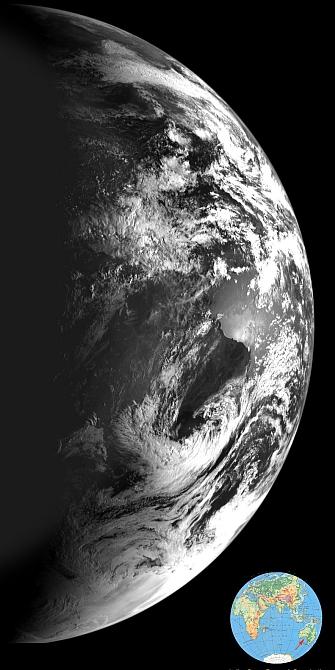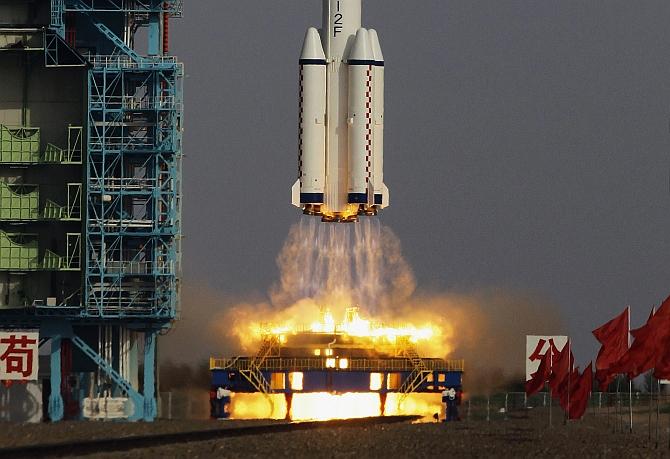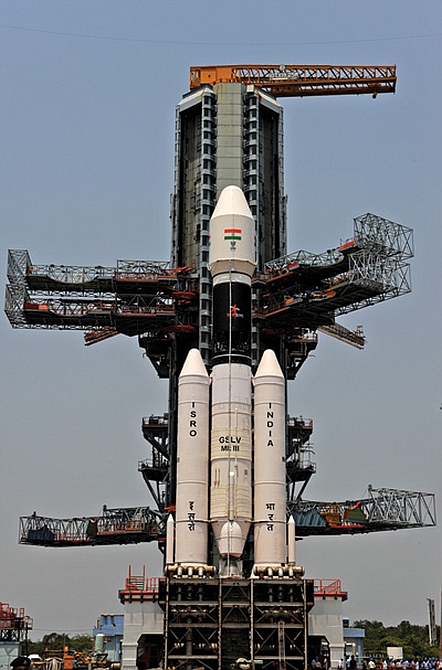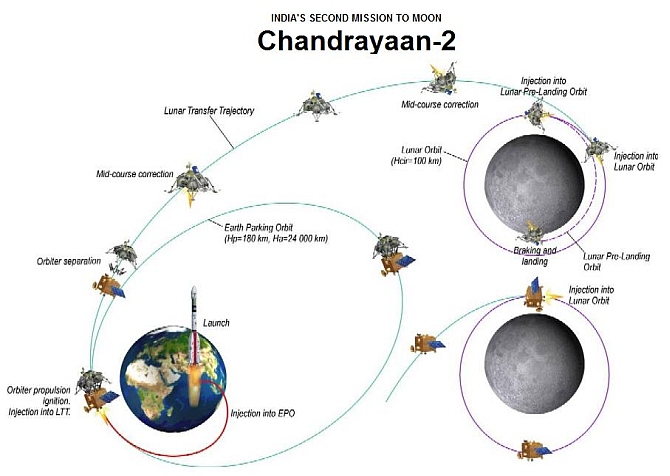Photographs: Reuters Dinesh C Sharma
The Indian government must support ISRO so that it is able to achieve its goal of becoming self-sufficient in all segments of the space business. The highly successful PSLV programme is a testimony to its capabilities. Now it needs to demonstrate the same with GSLV. Nothing should waver it from this goal. Not even competition with China, says Dinesh C Sharma
The launch of the Geosynchronous Satellite Launch Vehicle -- which was put off on August 19 minutes before blastoff due to a fuel leak -- has now been rescheduled for December putting the clock back for the Indian Space Research Organisation. While the Indian space programme is seen limping despite all its efforts, China is zipping ahead at great speed.
The GSLV programme is already running three years behind schedule. When ISRO was trying to take stock of the postponement of the crucial GSLV flight in Bangalore the past week, its Chinese counterpart was busy announcing plans to launch next mission to the moon with a soft landing vehicle -- a feat which only the US and the former USSR have achieved so far and which India plans to achieve with its second moon mission, Chandrayaan-2, sometime in 2015-16.
..
China is at least two decades ahead of India
Image: The Long March II-F rocket loaded with a Shenzhou-9 manned spacecraft carrying Chinese astronauts Jing Haipeng, Liu Wang and Liu Yang lifts off from the launch pad in the Jiuquan Satellite Launch Center, Gansu, ChinaPhotographs: Jason Lee/Reuters Dinesh C Sharma
In any case China is much ahead of India -- at least by two decades -- in the Asian space race. With the US space agency, NASA, decommissioning its shuttle programme and having no future plan to send manned missions to the moon, China is trying to quickly achieve all key landmarks in order to establish itself as a global space power.
Pumping massive resources into space technology development, China started concentrating on manned space missions as a priority. It succeeded by sending the first Chinese into space way back in 2003. In the past one decade, China has had five successful manned missions. India’s manned mission has been on drawing board for more than 10 years now.
China’s 2003 flight was followed up by another manned mission in 2008 which also included a spacewalk. In 2012, China demonstrated a manned docking mission which involved docking with its experimental space station, Tiangong1, with signals sent from the remote base in China. Three astronauts including the first Chinese woman were part of this mission. In June 2013, China announced another large mission that will dock with the space module.
...
ISRO's budget for the next 5 years is about Rs 40,000 crore
Image: The PSLV C-12 blasts off from Satish Dhawan space centre at SriharikotaPhotographs: Babu/Reuters Dinesh C Sharma
All the Chinese manned missions are being carried with the goal of setting up a permanent space station by 2020, on the lines of the International Space Station which the US, Russia and other countries are struggling to maintain jointly.
In contrast, ISRO’s plan to send an Indian into space has run into rough weather. No provision has been made for the manned mission in the current five year plan (2013-2017). Funds have been allocated only for pre-project research and development studies as for now.
It’s going to be a long haul for the space agency which has not been able to win necessary political support for its ambitious plan. The cost estimate for the manned mission made in 2009 was Rs 12,500 crore. This is huge sum, considering that all of ISRO’s budget for the next five years is about Rs 40,000 crore.
The manned space flight is a multifarious task that would involve development of several new technologies and testing them for manned modules. First and foremost, we need a rocket that can carry a heavier payload into space. This is the main stumbling block ISRO is facing currently.
It has not yet been able to demonstrate its capability in launching GSLV with a home-built cryogenic engine. In the absence of indigenous capability, ISRO still needs foreign launchers for heavier satellites -- as it did for launching its advanced multi-band communication satellite, GSAT-7, using the Ariane-5 launch vehicle of Arianespace from Kourou, French Guiana on August 30.
ISRO is working on an updated version of GSLV
Image: A mock-up of the GSLV Mark IIIPhotographs: Wikimedia Commons Dinesh C Sharma
Six GSLV flights have taken place so far but they all had Russian cryogenic engine. The one launched with indigenous cryogenic stage in 2010 had failed after launch. The August 19 flight of GSLV, which had to be aborted, had an indigenous cryogenic engine. We will now have to wait till December to see it perform when it is going to be finally launched.
In parallel, ISRO is working on an updated version of GSLV -- called GSLV Mark III -- for transporting heavier payloads. It will be tested to launch communication satellites. Then it will have to be ‘man-rated’ for manned flights. It would easily take ISRO beyond 2020 to be ready for a manned flight.
In the arena of scientific missions, China began relatively late but here too it is all set to surge past India. The first Chinese probe to the moon was launched in 2007. India launched its lunar orbiter, Chandrayaan-1, a year later but had to abort it much before its planned two years in space.
Though it was shortlived, Chandrayaan was successful in achieving a major scientific landmark -- discovering chemical signatures of water on the moon. The data sent by Chandrayaan is still being analysed. NASA, which had a payload on the Indian orbiter, announced last week yet another important discovery relating to water on the moon. On the other hand, the Chinese lunar mission had no similar scientific achievements to show.
...
India's 2nd lunar mission is scheduled for 2015-16
Image: The Chandrayaan-IIPhotographs: Courtesy: chandrayaan-i.com Dinesh C Sharma
Undeterred, China is now planning a second mission to the moon -- a landing mission -- later this year and has also announced its goal to send a manned mission to the moon sometime after 2020. In contrast, India’s second lunar mission is tentatively scheduled for 2015-16 with Russian help. Chandrayaan-2 is configured as a two module system comprising of an Orbiter Craft Module and a Lander Craft Module carrying a rover developed by ISRO.
Buoyed by its scientific success with the lunar mission, ISRO is set to send a similar mission to the Mars. The Mars Orbiter Mission would be India’s first interplanetary mission designed to orbit mars in an elliptical orbit of 372 km by 80,000 km. The Polar Satellite Launch Vehicle, which was used for the moon mission, will be used for the mars mission as well with necessary upgrades.
The mars mission is scheduled for October this year. It is several thousand times complex than the moon mission, considering the fact that it will have to travel the distance of 400 million kilometers compared to 0.4 million kilometers which Chandrayaan had to cover.
If successful, the mars mission would help the Indian space agency position itself as a serious player in the space science segment and may help it regain prestige it may have lost with its shaky position on the manned mission. On the home ground too, a successful mars mission is crucial for ISRO to win continued political support. On the other hand, China has geopolitical and strategic ambitions to establish itself as a global technology leader in outer space.
The Indian government must support the space agency so that it is able to achieve its goal of becoming self-sufficient in all segments of the space business. The highly successful PSLV programme is a testimony to its capabilities. Now it needs to demonstrate the same with GSLV. Nothing should waver it from this goal. Not even competition with China.
Dinesh C Sharma is a science journalist based in New Delhi






article